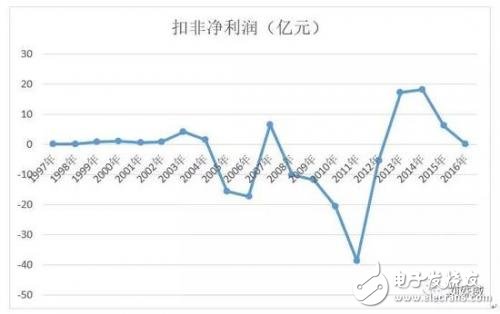On March 14, 2018, I visited the headquarters of BOE Technology Group Co., Ltd. (referred to as “BOEâ€) located in the Beijing Economic and Technological Development Zone, accompanied by Mr. Chen Yanshun, the CEO of BOE, along with Executive Vice President Mr. Zhang Yu and Senior Vice President Ms. Sun Wei. We had a detailed discussion on several key topics related to the company’s development.
BOE was established in 1993 and made its debut on the Shenzhen Stock Exchange's B-shares in 1997. In 2001, it issued additional A-shares on the same exchange. More than a decade ago, we conducted an in-depth analysis of BOE, when the company was just entering the display industry and faced significant financial challenges. It experienced consecutive losses and was under scrutiny from both the market and the public. The chart below illustrates BOE’s net profit, excluding non-recurring gains and losses, from its listing in 1997 up to 2016.

**What has happened to BOE since its listing? Why did it focus on developing display devices?**
**First, display technology is a strategic national asset.**
Originally known as the Beijing Electronic Tube Factory, BOE played a vital role in producing core electronic components for missiles and satellites during the 1950s and 1970s. In 1997, it set up the TFT-LCD (Thin Film Transistor Liquid Crystal Display) Technology Laboratory, followed by the establishment of the AMOLED (Active-Matrix Organic Light-Emitting Diode) Technology Laboratory in 2001.
The U.S. pioneered TFT-LCD technology, while Japan industrialized it. These displays are widely used in both military and civilian applications. Developed countries have long emphasized their development and manufacturing. For example, in 1994, the U.S. government launched the National Flat Panel Display Initiative (NFPDT) to support the development of flat panel display technologies for the military.
In 2005, BOE successfully launched its first TFT-LCD production line, marking China's entry into independent LCD manufacturing. Prior to this, China relied entirely on imports. From R&D to mass production, BOE spent eight years and invested heavily in research. By December 2017, the 10.5th generation TFT-LCD production line in Hefei was launched, placing China at the forefront of the global display industry.
In 2017, BOE also completed the mass production of its sixth-generation flexible AMOLED line in Chengdu, further solidifying its position in the emerging AMOLED sector. Starting from 1997 with the establishment of its TFT-LCD lab, BOE took 20 years to become a global leader in the display field. During this time, its leadership endured immense pressure and challenges. After two decades of effort, China finally mastered strategic display technology, laying the groundwork for future advancements in the Internet of Things.
**Second, core technology drives profitability.**
According to the US Patent Authorization Volume Report by IFI Claims, in 2016, Huawei ranked 25th and BOE ranked 40th among the top 50 US patent recipients. In 2017, Huawei moved up to 20th, while BOE reached 21st, securing the top spot in the ranking for the second year in a row.
BOE has also contributed to international standards in the display industry. In 2015, it developed the first Chinese-led IEC international standard for OLED display products, marking a major milestone.
After two decades of R&D investment, BOE’s performance began to grow rapidly in 2017. That year, BOE accounted for 25% of global TFT-LCD sales and became the largest supplier in terms of shipments. Its net profit was expected to reach around 7.5–7.8 billion yuan, a 314% increase compared to the previous year. In 2018, BOE continued to see strong growth.
**Third, future strategies.**
Having reached the top of the global display industry, BOE is now focused on expanding its market share. However, single-product sales have limits, so companies must plan ahead.
Display technology is the foundation of the Internet of Things. BOE is collaborating with leading companies across various sectors. For instance, it has partnered with Alibaba’s Box Ma Xiansheng, Jingdong’s Four Seasons Preferred, and Carrefour to provide electronic shelf labeling solutions using transparent displays. This helps with pricing, logistics, and customer behavior analysis.
BOE’s in-vehicle display systems are used by most major car brands worldwide. It is also working with residential developers to create new building materials that offer photovoltaic thermal solutions. Additionally, BOE combines its core technologies in display, sensing, AI, and big data with medical and life sciences to develop affordable genetic testing tools, reduce radiation from X-ray sensors, and enhance medical displays.
BOE has also partnered with Haier to create interactive transparent refrigerator doors, which feel like something out of science fiction but are incredibly practical.
Currently, BOE’s smart system revenue accounts for nearly 20% of total operating income. Its early investments in the Internet of Things are opening up new opportunities for future profitability.
>1200W LED Grow light Power Supply
LED light engine is replacing the traditional solutions like HPS, HID and MH rapidly especially in high power markets like stadium lights, pole lights and grow lights. Luminaire engineers find it headache to find a suitable 600W, 800W and 1000W LED drivers and even if they find some, they may suffer from the long lead time and expensive prices of those drivers. Then what is the solution from Fahold since we don`t make those drivers, yes, we have solutions of 1200W drivers.
big power led driver, grow light driver led, Q-boards driver, Bar grow light driver
ShenZhen Fahold Electronic Limited , https://www.leddriversupply.com